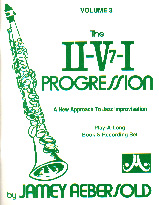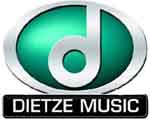 Secondary Dominants Secondary Dominants
Sage wisdom:
Don't let improvisation intimidate you. Even a clock that's stopped is right at least twice a day!
The way we analyze harmonic "function" in Western European music goes back more than four centuries. Even earlier than that, the concept of "cadence" had it's roots in Renaissance, but came to it's full sophistication in the Baroque era in the late 17th century. What we do today only takes the V7-I drive and adds a bit of harmonic color. Jazzers thrive on the tension/release "pull" of the Dominant or V (five) chord for a sense of motion. This agent of direction can materialize in a V7 (seventh) or any extension (V9, V+9, V7b13, etc.).
m7-5 Chords
We also need to throw the half diminished 7th chords (A.K.A. minor 7th with flatted fifth) into this category, as the seventh is simply a Dominant chord with the root stripped away. This is crucial for a mandolinist to understand! We have only four strings (or chord "voices") to express our harmony, we must choose the most relevant ones. Often we can substitute a m7-5 pattern for a V7 (V9), because likely the root of the five is voiced somewhere else in the ensemble (the bass player).
Clarification: Bm7b5 is more commonly expressed as Bm7-5
For Example:
Bm7-5 sub for G9
G9 = G, B, D, F, A which functions entirely complete when you remove the G. It becomes a Bm7-5 (or B half dim7). In the key of C, this is the Dominant Function, and it wants to resolve to the tonic or I (one) chord. This can be major or minor (although m7-5 chords are more commonly used in minor keys), and any tonic extension, Cmaj7, Cmaj7+11, Cm (add 9), etc...
Knowing this concept of Dominant Function allows us to "spice" up harmonically stagnant sections of music. For example, if you have a tonic chord that goes on for several measures, you can add mini-tonal centers, or some action to the music by going back and forth from V to I, even though the written music doesn't specifically call for it.
You can take this a step further into the concept of Secondary Dominants. This is simply preceding a chord with its Dominant Function, no matter what the key of the whole song is.

Clarification: if you are unaware of what the dominant chord is, examine the CIRCLE OF FIFTHS graphic. I've included. The V chord will be the chord preceding counter-clockwise. (G is V of C, D is V of G, A is V of D, etc.)
The excerpt from Green Dolphin Street gives two examples of this.

Click thumbnail to enlarge
In meas. 8, I've inserted an A7 chord, which pulls or resolves to the Dm7 in meas. 9. Note this is not the tonal center of the song, yet we've established a sort of mini-tonal center, a brief V7-i with D minor as a brief tonal center until it changes functions and becomes the ii7 for the next cadence, ii7-V7-Imaj7, or Dm7-G7-Cmaj7. The A7 is not written, but we've taken the liberty to add some "action" by inserting this chord.
We do something similar in the last measure, by adding the G7 (which is not written in the Real Book) at the end, taking us back to the tonic. In meas. 13, we have a classic ii7-V7-Imaj7, or Fm7, Bb7, Ebmaj7, which has lured us away from the key of C (the whole song!). By inserting the G7 in the last measure, we get "pulled" back to the key of C.
The Secondary Dominant is something you can add to quite a bit of jazz. It's a great way of harmonically supercharging sections of music that can benefit from the V7-I energy.
The next step is to add the Dominant Preparation chord (ii) prior to the for a ii-V7-I mini tonal center, but we'll save that for later...
Suggested Aebersold Resources:
 Vol 3: The II/V7/1 Progression Vol 3: The II/V7/1 Progression
A "Must-Have!" Understanding this cadence in the major and minor keys will allow you to do as I have in my limited jazz career, FOOL others into thinking you know how to define the key. Plus he fills you in on a "Real World" use of some fun modes & scales, like the Diminished, Half Diminished Whole tone (Pomeroy), Whole tone. The recordings are great for acclimating your ears to the "language" of Bird, Coltrane, Miles, etc.
SUGGESTED PREREQUISITES: VOLUME 2 and VOLUME 1.
Intermediate level. Probably the most important musical sequence in modern jazz! A must for all aspiring jazz players. Book contains all the needed scales and chords to each of the recorded tracks. These are written in the staff. Contains 120 written patterns that can be played with the various tracks on the recording, also includes three full pages of piano voicings that correspond to the tracks on the recording. Booklet contains a Scale Syllabus which allows you to find and use various substitute scales, just like professional musicians use. If you have been working on scales and chords, this book and recording set should be what you are looking for. A new concept in learning and applying basic jazz harmony. Allows you tracks to practice major, minor, dom. 7th, diminished, whole tone, half-diminished, Lydian and dim. whole tone scales and chords.
II/V7/I All Major Keys * G Minor Blues * Bebop Tune * V7+9/I All Keys * II/V7/I ln Three Keys * F Blues With An 8-Bar Bridge * Il/V7 Random Progressions * Ø/V7+9/I All Minor Keys
Vol 16: Turnarounds, Cycles, & II/V7s
The extension to Volume 3, but great licks for understanding how to "define" the key, and "turnaround" back to the original key...
SUGGESTED PREREQUISITE: VOLUME 3
Intermediate/advanced level. If you have been working on playing scales, chords, and harmony in general, this set is the next step towards getting your ears and fingers coordinated. This set is a continuation of Volume 3, but in much more depth. Set contains 5 Turnaround Tracks, 6 Cycle Tracks, Coltrane Blues, Some of The Things I Am (an exercise in substitute II/V7's), Joy Stick, 6 II/V7 Tracks, Coltrane Changes in All 12 Keys, Bb Rhythm Changes (slow tempo), and Guess What Key I'm In. Twenty-three tracks in all and almost all go through all 12 keys!!
Rhythm section is Jamey Aebersold, piano; John Clayton, bass; Mike Hyman, drums; and others.
5 Turnaround Tracks * 6 II/V7 Tracks * 6 Cycle Tracks * Coltrane Changes in All 12 Keys *Coltrane Blues Guess What Key I'm In * Bb Rhythm Changes * Some of The Things I Am ... and more *
Volume 84: Dominant 7th Workout
Man, some great phrases that cycle you through the circle of 5ths (intervals, not Jack Daniels...), stretching you out of the "comfort zone" of more standard Bluegrass keys.
The Dominant Seventh is possibly the most substituted, colored and altered sound in modern music. Its flexibility and distinctive nature made it a favorite of composers throughout the twentieth century and allowed it to dominate Blues and Rock'N'Roll. This Workout set will allow you to go through the dominant seventh chords and scales in all twelve keys with a swinging jazz rhythm section. The book is full of exercises and tips on working through the dominant sound completely, so that you can master it once and for all.
All these, plus I've got six or seven of my favorite collections of Standards for getting comfortable with just plain Jammin'. (Sometimes its good to just "blow" even when you don't completely know what you're doing. It makes the esoteric drilling, plodding pedagogical, & cerebral "Lab Science" come to life when you get to apply it!)
Now, I'm not advocating photocopying, but what I've done is pull about 3-6 pages out of Vol 3, 15, and 84, and put "copies" in a syllabus that I cart around just for practicing. Aebersold's text is fun to read but can be quite intimidating for the faint of heart. Really, the exercises are cleverly beneficial.
Coming soon to JAZZMANDO.COM!!!
Add some flavor to your comping with "spice" chords.
Sage wisdom:
It's one thing to speak the language. Quite another to speak the dialect...

If you can't find it locally, try Dietze Music!

Disclaimer: In the 'Information Age' of the 21st Century,
any fool with a computer, a modem, and an idea can
become a self-professed 'expert." This site does not
come equipped with 'discernment.'
|



